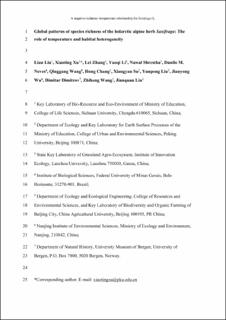Global patterns of species richness of the holarctic alpine herb Saxifraga: The role of temperature and habitat heterogeneity
Liu, Lian; Xu, Xiaoting; Zhang, Lei; Li, Yaoqi; Shrestha, Nawal; Neves, Danilo M; Wang, Qinggang; Chang, Hong; Su, Xiangyan; Liu, Yunpeng; Wu, Jianyong; Dimitrov, Dimitar; Wang, Zhiheng; Jianquan, Liu
Journal article, Peer reviewed
Accepted version
Permanent lenke
https://hdl.handle.net/11250/2992202Utgivelsesdato
2022Metadata
Vis full innførselSamlinger
- Department of Natural History [297]
- Registrations from Cristin [9791]
Sammendrag
The effects of contemporary climate, habitat heterogeneity and long-term climate change on species richness are well studied for woody plants in forest ecosystems, but poorly understood for herbaceous plants, especially in alpine–arctic ecosystems. Here, we aim to test if the previously proposed hypothesis based on the richness–environment relationship could explain the variation in richness patterns of the typical alpine–arctic herbaceous genus Saxifraga.
Using a newly compiled distribution database of 437 Saxifraga species, we estimated the species richness patterns for all species, narrow- and wide-ranged species. We used generalized linear models and simultaneous autoregressive models to evaluate the effects of contemporary climate, habitat heterogeneity and historical climate on species richness patterns. Partial regressions were used to determine the independent and shared effects of different variables. Four widely used models were tested to identify their predictive power in explaining patterns of species richness.
We found that temperature was negatively correlated with the richness patterns of all and wide-ranged species, and that was the most important environmental factor, indicating a strong conservatism of its ancestral temperate niche. Habitat heterogeneity and long-term climate change were the best predictors of the spatial variation of narrow-ranged species richness. Overall, the combined model containing five predictors can explain ca. 40%–50% of the variation in species richness. We further argued that additional evolutionary and biogeographical processes might have also played an essential role in shaping the Saxifraga diversity patterns and should be considered in future studies.
